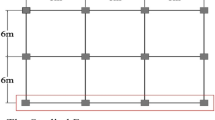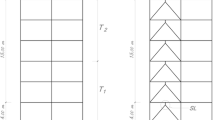Abstract
This paper presents a detailed systematic investigation to assess detailed dynamic behaviours of mid-rise moment resisting steel frames by performing nonlinear time history analysis using force analogy method. Both material and geometric nonlinearities have been considered in the analysis. Three building heights with seven earthquake ground accelerations have been examined. The building responses in terms of floor displacement, storey drift ratio and plastic energy dissipation have been investigated. It has been found that maximum seismic responses occur within 18–40% height of the building. Further, the position of maximum response along the building height has been seen to decrease as the height of building decreases. It has also been seen that building responses, when excited by short period ground accelerations, decreases when the building height increase; whereas building responses, when excited by long period ground accelerations, increases when the building height increases. In general, maximum seismic responses have been found to be more consistent with peak ground velocity rather than peak ground acceleration.













Similar content being viewed by others
References
FEMA-356. Prestandard and Commentary for the Seismic Rehabilitation of Buildings. FEMA-356, Washington, DC 2000.
E.V. Valmundsson, J.M. Nau, Seismic response of building frames with vertical structural irregularities. J. Struct. Eng. 123, 30–41 (1997)
S. Das, J.M. Nau, Seismic design aspects of vertically irregular reinforced concrete buildings. Earthq. Spectra. 19, 455–477 (2003)
A. Di Cuia, L. Lombardi, F. De Luca, R. De Risi, S. Caprili, W. Salvatore, Linear time-history analysis for EC8 design of CBF structures. Procedia. Eng. 199, 3522–3527 (2017)
D. De Domenico, G. Falsone, G. Ricciardi, Improved response-spectrum analysis of base-isolated buildings: A substructure-based response spectrum method. Eng Struct 162, 198–212 (2018)
H. Krawinkler, G.D.P.K. Seneviratna, Pros and cons of a pushover analysis of seismic performance evaluation. Eng. Struct. 20, 452–464 (1998)
A.K. Chopra, R.K. Goel, A modal pushover analysis procedure for estimating seismic demands for buildings. Earthq. Eng. Struct. Dyn. 31, 561–582 (2002)
Kalkan E, Kunnath SK. Method of modal combinations for pushover analysis of buildings. 13 th World Conf. Earthq. Eng. August 1–6, Vancouver, B.C., Canada, 2004.
S. Antoniou, R. Pinho, Advantages and limitations of adaptive and non-adaptive force-based pushover procedures. J. Earthq. Eng. 2469, 497–522 (2004)
Papanikolaou VK, Elnashai AS, Pareja JF. Limits of applicability of conventional and adaptive pushover analysis for seismic response assessment. Mid-America Earthquake Center, University of Illinois at Urbana-Champaign: 2005
Pinho RUI, Antoniou S, Casarotti C, Lopez M. A displacement-based adaptive pushover for assessment of buildings and bridges. Adv. Earthq. Eng. Urban Risk Reduct., 2006, p. 79–94.
S.M. Wilkinson, R.A. Hiley, A non-linear response history model for the seismic analysis of high-rise framed buildings. Comput. Struct. 84, 318–329 (2006)
S. Krishnan, C. Ji, D. Komatitsch, J. Tromp, Performance of two 18-story steel moment-frame buildings in Southern California during two large simulated san Andreas earthquakes. Earthq. Spectra. 22, 1035–1061 (2006)
S. Krishnan, M. Muto, Sensitivity of the earthquake response of tall steel moment frame buildings to ground motion features. J. Earthq. Eng. 17, 673–698 (2013)
UBC. Uniform Building Code. Int. Conf. Build. Off., Whittier, California, 1997: 1997.
Eurocode 8. Design of structures for earthquake resistance - Part 1: General rules, seismic actions and rules for buildings. 2004.
L. Moschen, C. Adam, D. Vamvatsikos, A response spectrum method for peak floor acceleration demands in earthquake excited structures. Probabil. Eng. Mech. 46, 94–106 (2016)
S.W. Liu, R. Bai, S.L. Chan, Dynamic time-history elastic analysis of steel frames using one element per member. Structures 8, 300–309 (2016)
E. Kalkan, S.K. Kunnath, Adaptive modal combination procedure for nonlinear static analysis of building structures. J. Struct. Eng. 132, 1721–1731 (2006)
C. Meyer, Inelastic dynamic analysis of tall buildings. Earthq. Eng. Struct. Dyn. 2, 325–342 (1974)
C. Uang, Q.-S. Yu, A. Sadre, D. Bonowitz, N. Youssef, J. Vinkler, Siesmic responses of an instrumented 13-story steel frame building damaged in the 1994 Northridge earthquake. Earthq. Spectra. 13, 131–149 (1997)
C.E. Ventura, Y. Ding, Linear and nonlinear seismic response of a 52-storey steel frame building. Struct. Des. Tall Spec. Build. 45, 25–45 (2000)
M.G. Mulas, A structural model for panel zones in non linear seismic analysis of steel moment-resisting frames. Eng. Struct. 26, 363–380 (2004)
M.A. Hariri-ardebili, Y. Zarringhalam, H.E. Estekanchi, M. Yahyai, Nonlinear seismic assessment of steel moment frames using time-history, incremental dynamic, and endurance time analysis methods. Sci. Iran 20, 431–444 (2013)
V. Mokarram, M.R. Banan, An improved multi-objective optimization approach for performance-based design of structures using nonlinear time-history analyses. Appl. Soft. Comput. J. 73, 647–665 (2018)
K.K.F. Wong, R. Yang, Inelastic dynamic response of structures using force analogy method. J. Eng. Mech. 125, 1190–1199 (1999)
G. Li, Y. Zhang, H.-N. Li, Nonlinear seismic analysis of reinforced concrete frames using the force analogy method. Earthq. Eng. Struct. Dyn. 43, 2115–2134 (2014)
FEMA-350. Recommended Seismic Design Critria for New Steel Moment-Frame Buildings Fema 350. FEMA-350, Washington, DC 2000.
MathWorks Inc. MATLAB R2012b 2012.
Wong KKF. A new analytical method for solving nonlinear stability problems of framed structures. Proc. Annu. Stab. Conf. Struct. Stab. Res. Counc., Toronto, Canada, March 25–28, 2014: 2014.
Wong KKF, Speicher MS. Dynamic effects of geometric nonlinearity on inelastic frame behavior for seismic applications. Proc. Annu. Stab. Conf. Struct. Stab. Res. Counc. Nashville, Tennessee, March 24–27, 2015, 2015, p. 1–20.
Computers and Structures Inc. SAP2000, Integrated Software for Structural Analysis and Design 2011.
S.-H. Chao, C.-H. Loh, Inelastic response analysis of reinforced concrete structures using modified force analogy method. Earthq. Eng. Struct. Dyn. 36, 1659–1683 (2007)
G. Li, Y. Zhang, H. Li, Seismic damage analysis of reinforced concrete frame using the force analogy method. J. Eng. Mech. 139, 1780–1789 (2013)
G. Li, Z. Yu, L. Hong-Nan, Nonlinear seismic analysis of reinforced concrete bridges using the force analogy method. J. Bridg. Eng. 20, 1–12 (2014)
K.K.F. Wong, Predictive optimal linear control of inelastic structures during earthquake. Part II. J. Eng. Mech. 131, 142–152 (2005)
M. Pang, K.K.F. Wong, Predictive instantaneous optimal control of inelastic structures based on ground velocity. Struct Des Tall Spec Build 15, 307–324 (2006)
S.S. Ningthoukhongjam, K.D. Singh, Inelastic time history analysis of mass irregular moment resisting steel frame using force analogy method. Adv. Struct. Vib. Lect. Notes Mech. Eng. (2021). https://doi.org/10.1007/978-981-15-5862-7_15
Ningthoukhongjam SS, Singh KD. Mass irregularity effect on seismic response of moment-resisting steel frame by nonlinear time history analysis using force analogy method. Struct Des Tall Spec Build 2020;n/a:e1823. https://doi.org/10.1002/tal.1823.
K.K.F. Wong, J. Johnson, Seismic energy dissipation of inelastic structures with multiple tuned mass dampers. J. Eng. Mech. 135, 265–275 (2009)
K.K.F. Wong, Seismic energy dissipation of inelastic structures with tuned mass dampers. J. Eng. Mech. 134, 163–172 (2008)
G. Li, H.-N. Li, Seismic response analysis of structure with energy dissipation devices using force analogy method. Struct. Des. Tall Spec. Build 20, 291–313 (2011)
K.K.F. Wong, D. Zhao, Uncoupling of potential energy in nonlinear seismic analysis of framed structures. J. Eng. Mech. 133, 1061–1071 (2007)
X. Zhang, K.K.F. Wong, Y. Wang, Performance assessment of moment resisting frames during earthquakes based on the force analogy method. Eng. Struct. 29, 2792–2802 (2007). https://doi.org/10.1016/j.engstruct.2007.01.024
G. Li, K.K.F. Wong, Theory of Nonlinear Structural Analysis: The Force Analogy Method for Earthquake Engineering (Wiley, Singapore, 2014)
K.D. Kim, M.D. Engelhardt, Beam-column element for nonlinear seismic analysis of steel frames. J. Struct. Eng. 131, 715–724 (2005)
B. Akbas, J. Shen, H. Hao, Energy approach in performance-based seismic design of steel moment resisting frames for basic safety objective. Struct. Des. Tall Build 10, 193–217 (2001)
C. Chou, C. Uang, A procedure for evaluating seismic energy demand of framed structures. Earthq. Eng. Struct. Dyn. 244, 229–244 (2003)
S.A. Mahin, V.V. Bertero, An evaluation of inelastic seismic design spectra. J. Struct. Div. 107, 1777–1795 (1981)
K.K.F. Wong, Y. Wang, Energy-based design of structures using modified force analogy method. Struct. Des. Tall Spec. Build 12, 393–407 (2003)
H. Sucuoǧlu, A. Nurtuǧ, Earthquake ground motion characteristics and seismic energy dissipation. Earthq. Eng. Struct. Dyn. 24, 1195–1213 (1995)
VDC. Strong-Motion Virtual Data Center, http://strongmotioncenter.org/vdc/scripts/default.plx 2012.
Funding
No funding.
Author information
Authors and Affiliations
Corresponding author
Ethics declarations
Conflict of interest
The authors declare that they have no conflict of interest.
Additional information
Publisher's Note
Springer Nature remains neutral with regard to jurisdictional claims in published maps and institutional affiliations.
Appendices
Appendix A
Formulation of FAM in Nonlinear Dynamic Problems
Dynamic equation of motion resulted from earthquake excitation
where Fa(t) is imposed load on the structure resulted from geometric nonlinearity (mainly P-∆ effect). This additional force vector Fa(t) is related to the lateral displacement vector x(t) as:
where Ka is a stiffness formed due to gravity load. Value of Ka depends on column height but is not a function of time.
where KL is the elastic stiffness that depends on gravity load, whereas KG(t) is the stiffness that keeps changing due to variation in axial load during earthquake excitation. The elastic stiffness KL will be computed once initially, and it may be used consistently until the entire nonlinear dynamic problem is solved, which becomes the unique advantage in FAM.
State Space Methods in FAM
After the application of static condensation, the equation of motion becomes
Let,
where \(\overline{K }\) e represents the elastic stiffness of the whole structure. Substituting the value of \(\overline{K}_{{\rm{e}}}\) into equation (15.)
Material nonlinearity term \(\overline{K }\left(t\right){x}_{d}"(t)\) and geometric nonlinearity term \(-{\overline{K} }_{\mathrm{G}}\left(t\right){x}_{\mathrm{d}}(t)\) on the right hand side of Eq. (16) can be considered as the equivalent forces applied due to nonlinearities on the structures. Dynamic equation of motion (16) can be solved by using state space method. Refer Wong and Speicher [31] for detail formulation.
Rights and permissions
About this article
Cite this article
Ningthoukhongjam, S.S., Singh, K.D. Analysis of Mid-Rise Moment Resisting Steel Frames by Nonlinear Time History Analysis using Force Analogy Method. J. Inst. Eng. India Ser. A 102, 901–918 (2021). https://doi.org/10.1007/s40030-021-00577-2
Received:
Accepted:
Published:
Issue Date:
DOI: https://doi.org/10.1007/s40030-021-00577-2




